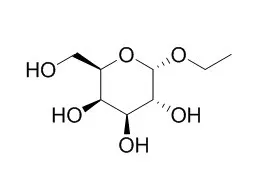| Structure Identification: |
| International Symposium on Analytical Chemistry for Chinese Scholars. | | Analysis of sugars in Acanthopanax senticosus (Rupr. et Maxim) by HPLC with ELSD detection.[Reference: WebLink] | Ciwujia (in Chinese), the dried roots and rhizomes of the plant of Aranthopanax senticosus (Rupr. et Maxim), is a widely used Traditional Chinese Medicine (TCM), which is native to Heilongjiang Province.
METHODS AND RESULTS:
The hiomedical effects of Acanthopanax senticosus (Rupr. et Maxim) have been experimentally or clinically demonstrated, including anticancer, immune modulating, antifatigue, anti-age and tanquilization, etc. It is also made into health foods recently due to the above functions. Its active components have been separated and identified as eleutheroside A, eleutheroside B, eleutheroside B1, Eleutheroside C, eleutheroside D, eleutheroside E, eleutheroside F, eleutheroside G, flavonoids, sugars and so on, of which sugars have attracted great attention for a long time. In this research, a simple and rapid HPLC coupled with Evaporative Light Scattering Detection (ELSD) method was developed for the determination of glucose and sucrose in Acanthopanax senticosus (Rupr. et Maxim). The HPLC separation was performed on a CHROMATOREX NH2 column using acetonitrile-water (84.5: 15.5, v/v) as mobile phase at a flow rate of 1 mL/min. The drift tube temperature of ELSD was set at 100℃, and with the nitrogen flow-rate of 2.5L/min. The linear ranges were from23.2 to 116mg·L-1 1 for glucose, and from99.6 to 496.5 mg · L-1for sucrose. All regression coefficients were more than 0. 9990. The detection limits (Signal/Noise=3) obtained were 3.87ng and 3.31ng for glucose and sucrose, respectively.
CONCLUSIONS:
The method was first used for separation and determination of sugars in Traditional Chinese herb Acanthopanax senticosus (Rupr. et Maxim) without prior derivatization, and the results were satisfactory. |
|






 Cell. 2018 Jan 11;172(1-2):249-261.e12. doi: 10.1016/j.cell.2017.12.019.IF=36.216(2019)
Cell. 2018 Jan 11;172(1-2):249-261.e12. doi: 10.1016/j.cell.2017.12.019.IF=36.216(2019) Cell Metab. 2020 Mar 3;31(3):534-548.e5. doi: 10.1016/j.cmet.2020.01.002.IF=22.415(2019)
Cell Metab. 2020 Mar 3;31(3):534-548.e5. doi: 10.1016/j.cmet.2020.01.002.IF=22.415(2019) Mol Cell. 2017 Nov 16;68(4):673-685.e6. doi: 10.1016/j.molcel.2017.10.022.IF=14.548(2019)
Mol Cell. 2017 Nov 16;68(4):673-685.e6. doi: 10.1016/j.molcel.2017.10.022.IF=14.548(2019)